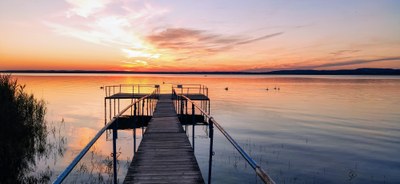All official European Union website addresses are in the europa.eu domain.
See all EU institutions and bodiesThe European Environment Agency’s most comprehensive assessment of Europe’s environment, climate and sustainability has been co-created with 38 countries. More than 1,000 experts from over 600 institutions contributed to the upcoming Europe’s environment 2025 report, to be published at the end of September. We asked project coordinator Tobias Lung how he brought it all together and what makes this edition different.
How is Europe's environment 2025 different from previous editions?
This is a report that comes out every five years and I have been involved in producing them for over 12 years — this being my second time as coordinator.
We tried to learn from past editions and use the best parts from each of them. We had the ambition to make this edition of Europe's environment report a strong digital product (incorporating an AI search for the first time), and to strengthen the country representation and ownership.
All this, while retaining a European level assessment that weaves together the environmental, economic and social dimension into a convincing evidence-based narrative. A novelty in the 2025 edition is the way we co-created country profiles with our member and cooperating countries.

What is the role of the countries in this edition?
From the start in early 2022, we floated the idea of genuine co-creation. In 2020, the previous report was well received in Brussels, and also in the member countries, as an overall European assessment and benchmark. Many of our audiences regarded the report as cutting-edge and telling a very important story, with the systemic focus it took. At the same time, the colleagues in the countries felt that the information at national level was underrepresented.
We wanted to keep the strong, systemic analysis from 2020 but also make sure that countries could see themselves better reflected in the results. So we designed a process to jointly develop a new assessment not already published anywhere else, instead of creating summaries of existing national state of environment reports. This resulted in three distinct assessments for each country profile: key trends in climate and environment, socio-economic developments, and changes in the food, mobility and energy systems. We tested the approach with a pilot group of 8–10 countries in 2023 and then expanded it to the 38 countries which are members of the EEA and cooperation countries of full implementation in 2024-25.
Overall, the response from the countries was positive. Of course, there were debates about indicator choices and technical details. In a few cases, compromises were needed, such as allowing a country to add a short note expressing reservations about a particular indicator. But the general spirit during the development phase was very constructive.
Have you ever thought the collaboration might fail?
No. From the beginning we pushed for an ambitious co-creation approach. If we only talk about co-creation without doing it, we lose credibility. There were some tense moments, but we managed to find solutions.
Where do the concrete examples come from?
The country profiles draw on selected EEA datasets, complemented with national data and examples of measures and actions. The main report also includes numerous country examples as text boxes, and for those we drew on existing databases and case studies from previous EEA work, such as Climate-ADAPT, and sometimes updated them. Countries were consulted on the examples and often improved them. Europe’s environment 2025 is full of case studies—on nature conservation, waste prevention, recycling, land management, and more—showing good practice from across Europe.
What do you expect this time, in terms of impact?
Impact is always hard to plan. The 2020 edition had a big impact, feeding directly into the European Green Deal as new policy. The timing was simply perfect.
This time we cannot predict global or European events around the publication date. But the timing may again be favourable. With many environmental ambitions currently being challenged, this report can serve as a wake-up call. Our message is that nature is fundamental to Europe’s social and economic prosperity and future, and thus lowering environmental and sustainability ambitions must not be an option.
The argument is clear. Europe cannot be competitive or secure if environmental degradation and climate change are not addressed.
What lessons might shape the next edition?
We will evaluate impact carefully. Coordination across 38 countries is always challenging, but overall, the process has worked. The big innovation—genuine co-creation with countries—should be built upon. And we need to take steps to fully exploit the evolving opportunities of digitalisation.









